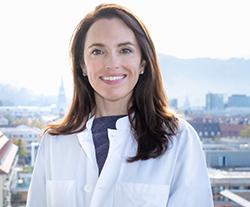Lungs Want Fresh Air Only

Professor Dr. Daiana Stolz, Medical Director of the Department of Pneumology at the Medical Center - University of Freiburg, has a very personal story to tell about COPD. Her grandmother suffered from the lung disease and found it difficult to breathe for years. This was a major reason for her granddaughter to study medicine and specialize in curing COPD.
"Unfortunately, COPD is often discovered far too late," says Professor Dr. Daiana Stolz. This is because a person's lungs have so much reserve that the loss of the finer bronchi - the so-called bronchioles - only becomes noticeable late. COPD is the abbreviation for "Chronic Obstructive Pulmonary Disease". The disease is not yet curable. This makes it all the more important to recognize it early and take countermeasures. There are no real early symptoms of COPD. "The symptoms - morning sputum production, coughing and shortness of breath - that can indicate the onset of chronic obstructive pulmonary disease are often overlooked as warning signs and eventually become a way of life," says Professor Stolz. The disease becomes a seemingly normal part of life. Because the deterioration of lung function usually occurs very slowly, "we do not notice the loss of lung reserve until a large part of it has already been lost," she regrets. Once lung tissue is partially or completely damaged, it is irretrievably lost.
Everything that is inhaled is harmful
COPD can be caused by many things. First and foremost, there is cigarette smoking as well as inhaling vaporized liquids through vaping (e-cigarette), shisha or hookah. Professor Stolz advises to "Stop smoking immediately to avoid losing even more lung function. The lungs are made to breathe only fresh air."
Passive smoking, air pollution and contact with chemical substances that are inhaled can also lead to COPD. Last but not least, there are diseases such as HIV, tuberculosis or congenital genetic mutations that can cause lung disease, too.
More room for healthy tissue
COPD permanently narrows the airways and cannot be cured. Medication can only slow down and lessen the disease. Physical activities such as walking and gardening as well as respiratory physiotherapy support the therapy. People with COPD find it particularly difficult to breathe. In their chronically over-inflated lungs, the air builds up in large bubbles and robs the healthy lung tissue of space. An endoscopic procedure known as lung volume reduction, for example, is offered as a gentle treatment method to reduce the volume of the lungs. The surgeon uses the bronchoscope to insert umbrella-shaped valves into the bronchi with the aim of shrinking the damaged and over-inflated tissue and making room for the healthy tissue. "This allows patients to take in more oxygen from the air again and breathe more easily," Professor Stolz explains.
Lancet special publication on diagnosis, treatment and prevention
In order to better understand how COPD develops, Professor Stolz conducts basic research. This knowledge can then be used to improve diagnostics or develop new drugs to alleviate or even stop the chronic disease. This scientific expertise is recognized worldwide. Daiana Stolz is the lead author of a recent special publication in the renowned British journal Lancet, in which 29 leading international COPD experts have summarized important impulses for improved diagnosis, treatment and prevention. In addition to consistent protection against air pollution, the specialists propose a redefinition of disease types, describe significantly expanded diagnostics, and call for greater investment in COPD research.
Please find more information here.
Back